eISSN: 2576-4470


Review Article Volume 8 Issue 1
Research Institute for Quality of Life (RIQL), Romania
Correspondence: Adina Mihăilescu, Research Institute for Quality of Life (RIQL), Standard of Life, Romania, Tel 0787655002, Email adina.mihailescu@yahoo.com
Received: February 14, 2024 | Published: February 26, 2024
Citation: Mihăilescu A. Media violence and its effects in modern societies. Sociol Int J. 2024;8(1):39‒43. DOI: 10.15406/sij.2024.08.00374
Violence in human society is nothing new, even in current times. Everything is constantly changing. The media is a criminogenic factor in itself, and on the other hand, an enhancer of all other factors, of all other causes of increased crime, which forces an increase in ways of studying and combating the harmful social influence it can exert, beyond its undeniable role in the progress of mankind.
Keywords: internet, mass media, social media, aggressive behaviour, society
Violence in human society is nothing new, even in current times. It is a form of intolerance to various factors, even if we are considering a developed society with well-defined laws. Everything is constantly changing. There are several types of violence: physical, verbal, psychological, but the first two are the most common. In the following we will stop at some bibliographic references, which will help in conceptually clarifying the term violence. A first and significant bibliographic reference is the Explanatory Dictionary of the Romanian Language in which: "violence is the lack of mastery in words or deeds and the use of brutal force".1 Eric Debarbieux, a specialist in the issue of violence, believes that violence is "a brutal or continuous disorganization of a personal, collective or social system and which translates into a loss of integrity that can be physical, material or psychological".2 This disorganization can manifest itself through aggression, through the use of force, consciously or unconsciously, but violence can exist, only from the victim's point of view, without the aggressor having the intention to harm. In recent years, many researchers have focused their attention on violence promoted by the media. A starting point was "England of the 70s", shaken by conflicts between government and trade unions, the rise of hooliganism and an ever-increasing crime rate. Researchers of those times tried to explain the causes of these forms of violence through the film "A clockwork Orange", which created a wave of controversy by the fact that in the first 15 minutes of the film were present forms of violence and incitement to violence. At the time, scholars believed that many people were influenced by this film, due to the waves of murders, robberies and rapes triggered in those years in English society.
In the US, three extensive studies were conducted on violence in the media between 1967 and 1989. The first research was conducted by George Gebner and his team,3 and ran for 22 years, starting in 1967. The result of the study showed that 80% of the shows presented in the media contained elements of physical violence. The second study was conducted by a team of researchers led by Bradley Greenberg, who estimated that American television shows approximately 14.6 acts of violence per hour.4 The third study was conducted in 1990 and was conducted by the National Cable Television Association. This study nuanced the concept in question, demonstrating that 60% of programs broadcast on American television contain some form of violence. The researchers wondered if there was any direct link between seeing violence on television and engaging in violent behavior. Television and long television watching can awaken in the subconscious of man primal instincts, which can lead to violent manifestations. Researchers have been trying to find the immediate effects that violent media has on humans.
A first effect would be imitation. This effect was studied by Albert Bandura through experiments known as the Bobo doll.5 The name of these experiments comes from the use of a flammable plastic doll, which was more often hit by children after watching television broadcasts containing acts of violence. It has been observed that the effect of imitating violent behavior in children also depends on the popularity of the aggressor. An example of this was the movie "Bonnie and Clyde", where well-known actors, who played the two villains, aroused much controversy.
A second effect is arousal, when the person watching a violent movie can see that movie as an exceptional stimulus for his body. Thus, an exciting film can produce an excess of adrenaline in the viewer's body.
Among the multiple causes of the social phenomenon of crime, along with economic, demographic, socio-cultural factors, which in turn are structured according to family influence, school activity, social environment, an increasingly prominent role is played by the impact of mass media.6 Of course, these factors have different weights depending on the approach, the author, but in essence most criminologists devote special concern to the criminogenic factors stated above, due to the causal link on the behavior of offenders. In the modern information society, an important share is gained by mass media, the Internet and social media, with both positive and negative influence on people's behavior. It is well known that attempts are currently being made to various ways - rejected by civil society - to control and censor, in terms of morality and security, messages transmitted on the Internet. Television is perceived in an extreme way, as a school of crime and delinquency, especially juvenile delinquency in that young people tend to mimic in everyday life the violence they encounter on the small or big screen.
An interesting point of view can be found in the work of a team of UNAP specialists, coordinated by Gheorghe Văduva,7 according to which "media terrorism is also the avalanche of murders, rapes, beatings transmitted evening after night by all television stations", which represents an extremely trenchant analysis of the media phenomenon. The link between media and terrorism is dealt with directly by numerous researchers, including Isabelle Garcin-Marrou's studies,8 which analyse the complicity between media and terrorism. In his opinion, an explicit formulation of this conception is found in the famous statement of former British Prime Minister Margaret Thatcher who claimed that: "terrorists feed on media advertising".
The media is a criminogenic factor in itself, and on the other hand, an enhancer of all other factors, of all other causes of increased crime, which forces an increase in ways of studying and combating the harmful social influence it can exert, beyond its undeniable role in the progress of mankind. Recent studies show that the influence of the main audiovisual media - television, internet and cinema - have an extremely harmful social role by promoting subculture, by focusing on ratings, in order to attract masses lacking education and value systems, permeable to deviationist, criminogenic behavior. Criminologists prioritize violence in the media and, in particular, video violence. Human culture, literature, print media, cinema have always had a marginally negative influence on individuals or social categories. But never before has this influence been exerted as strongly as it began to manifest itself with the audiovisual explosion.
Patterns of aggressive behavior cultivated by mass media manifested in marginal environments of society
Patterns of negative behavior are cultivated by commercial films, which address themes with effects on the instinctual, subconscious plane, which has a strong influence on all categories of spectators, but mainly on young ones, in the formative period. There has been an increase in the aggressive level among those who watch such cinematographic productions, violent programs determining a behavior similar to the pursued "hero", transposition into the "skin of the character" and, through imitation, committing violent, spontaneous, unpremeditated acts.
Criminologists Marwin Wolfgang and Franco Ferracuti,9 show that educational violence is transmitted from generation to generation in response to everyday stress, especially when the subculture of violence has merged with the subculture of drugs. These subcultures of violence of failed families, clans and subculture of drugs and possession of firearms, prostitution are widely cultivated by cinema, not always by supporting theses of combat, of rejecting such phenomena. Cinema, through a series of productions, cultivates such aggressive behavior.
A criminogenic factor cultivated by cinema as part of the media is the theme of revenge, so poor-class individuals swap the role of victim to attacker, which causes violent subculture values and attitudes to be passed down from generation to generation.
In marginal areas of society, successive generations will face the same typical, similar problems in different countries and regions, triggered by factors such as: poverty, inculture, family and social violence. The standard of living of families has been affected over time, in different ways, providing a concrete picture of the quality of life of the population and contributing to taking necessary measures, through socio-economic policies, for the benefit of the members of society. In different periods of time, certain segments of the population have been in difficulty, barely providing the necessary support for survival. It has been found that in times of economic austerity, people resize their consumption, in the sense of compressing or closing certain types of expenditure. At the end of 2022 (Chart 1), Romania's active population was 8.27 million people, of which 7.8 million people were employed: 6.6 million employees and 1.14 million employers, self-employed and unpaid family workers. The data of the National Institute of Statistics show that the segment 15-64 years had an employment rate of 63.1%, of which higher for men 71.5%, compared to that of employed women 54.4%.10 The employment rate of young people (15-24 years) was 19.7%, and that of elderly people (55-64 years) of 46.7%. Of the total employed persons, 55.9% worked in services, 32.8% in industry and construction, and 11.3% in the agricultural sector.
If we analyze different income categories (average wage, minimum wage, child allowance) in relation to the prices of goods and services on the market, we find that, in Romania, between 1989 and 2023:
Net average salary. As can be seen in Chart 2, the dynamics of the average net real wage, correlated with the evolution of prices for goods and services on the market, was perhaps the only income indicator that recorded a positive evolution, especially since 2000, when it practically reached a minimum. After 2000, the average net real wage in the economy has an increasing trend until 2008, when the economic crisis begins to be felt. After this year it has a decrease in 2010, after which it returns to the upward trend. 2014 marks the same level as 2008; The indicator climbed well after 2014.
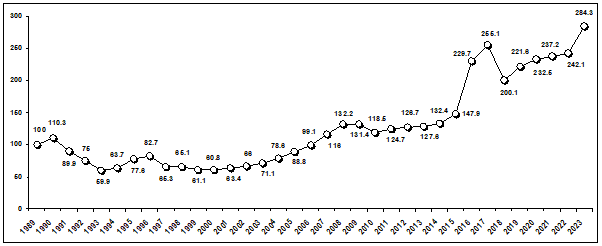
Chart 2 Dynamics of real net average wage, October 1989–2023 (1989=100%).
Source: RIQL database [12]; calculations made by the author.
The net minimum wage is another important indicator of social policy. The real value of the real net minimum wage had a downward trend in the 1989-2023 time horizon (Chart 3), reaching a maximum level in 2000 of 24%, i.e. a quarter of food, non-food and services goods that could be purchased in the base year, 1989. The situation has improved since 2009 and then decreased again by 2013. The period of global economic crisis affected all categories of employees, but especially those paid at the level of the minimum wage. The value of the minimum wage indicator in 2023 increased as a result of political decisions, reaching a value of 171% compared to the 1989 calculation base.
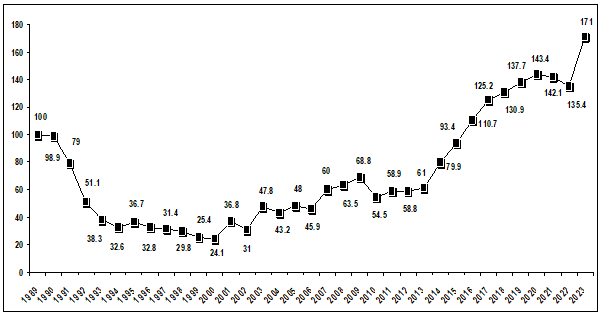
Chart 3 Dynamics of real net minimum wage, October 1989–2023 (1989=100%).
Source: RIQL database [12]; calculations made by the author.
Child allowance. It experienced a decrease in value in several stages: (1) 1990–1996 ; (2) occurs from 1997 to 2000, the minimum point being recorded in 2000, 22.3% first child allowance and 36.6% second child allowance; (3) started in 2001 and lasted until 2010; (4) 2010-2015 in which the first child allowance reached a purchasing power of 37% and the second child allowance of 43.5%; (5) has been manifested since 2015-2018, when the purchasing power of the first child reaches 70.6% and of the second child 82.9%, values more reasonable than in previous years, but reflecting a rather precarious attention paid to children in Romanian society (Chart 4).
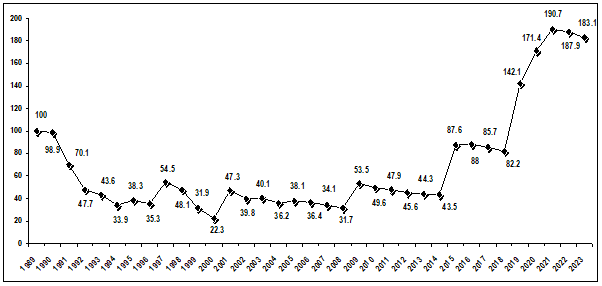
Chart 4 Dinamics of real allowance for the first child, Octomber 1989 –2023 (1989=100%).
Source: RIQL database;12 calculations made by the author.
Following the above, we will see in the following graphs how the purchasing power of different income combinations manifested itself in relation to the decent minimum basket and the minimum subsistence basket.13
The family of two active adults with two dependent children of school age and with an income composed of a net average salary and the allowances of two children, during the analyzed period 1989-2018, was in difficulty to cover their goods and services on the market from the beginning. Only after 2016, this family's income could cover the minimum decent living basket and the survival basket in 2015 (Chart 5).
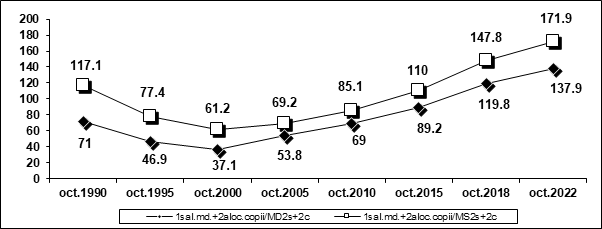
Chart 5 Family of 2 adults and 2 children: 1 average salary and 2 child allowances, reported to the minimum decent and subsistence basket, urban area
Source: RIQL database;12 calculations made by the author.
In Chart 6, an income consisting of a net minimum wage and the allowances of two school-age children is not enough to cover a minimum basket of decent living, this income covering 55% of the basket only at the beginning and end of the analysis years. The most dramatic years for this family were 2000 (11.6%), 1999 (12.9%) and 1994 (14.8%), when that income did not cover even 15% of the decent minimum basket. As for the minimum survival threshold, it was best covered only in 1989 (90.7%), then the situation deteriorates visibly, being covered about a quarter (25%) and at most a third (33%) of this threshold, for a long period of time, between 1993 and 2013.
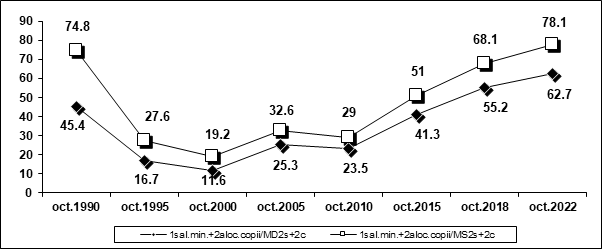
Chart 6 Family of 2 adults and 2 children: 1 minimum wage and 2 child allowances, compared to the minimum decent and subsistence basket, urban area.
Source: RIQL database;12 calculations made by the author.
The incomes of various families with children could not keep up with the price increases for products and services on the market. This has led over time to a deterioration in the quality of life of these families. Situaţia este critică și pentru cuplul cu un venit format dintr-un salariu minim şi două alocaţii de copii din mediul urban. Acest venit nu a acoperit nici minimul de subzistenţă. Between 1991 and 2015, the income described did not cover half of the decent living minimum of the reference year, 1989.
Virtual reality – model that encourages aggressive behavior in real life
Television is 70-80% destined for films and shows, which cultivate social irresponsibility and individual "models" that succeed in life by violating the law, norms of social coexistence, public order. These television programmes constitute criminogenic factors and a cause of crime among the young population of maximum gravity. A renowned researcher in media violence, George Gerbner, gave a definition in his work "Violence in TV dramas – trends and symbolic functions" (1972),14 thus:"Violence is an action that painfully disturbs and dangerously physically, psychologically and socially the well-being of individuals or groups. Its effects can range from trivial to catastrophic. Violence can occur naturally or be created by humans, it can act against people or property, it can be justified or not, it can be real or symbolic, spontaneous or gradual." Studies show that the hours spent in front of the small screen influence in a decisive way the behavior of many individuals who end up breaking the law.
A theory supported by sociological research demonstrates that violent characters and messages lead to the reinforcement of aggressive tendencies, which individuals hold depending on how they received a certain education and socialization in the family and in the environment in which they live. Also much more permeable to such messages of violence are people suffering from a deficit of affective stability. Therefore, the media only enhances pre-existing aggressiveness. An even more harmful role is assigned by researchers to fictional violence, due to the fact that through its features it tends to blur and mitigate the effects associated with real violence. In a paper dedicated to this issue,15 the most harmful factor is that in which "the mass media is synonymous in the collective mind with a tribune of values worth following, which constitutes a paradox when it comes to non-values, everything that constitutes criminal behavior, blamed and condemned by society". In modern societies, the media and especially the audiovisual have become important components and sometimes even more important than real life. In fact, virtual space is a duplicate of real space, which feeds aggressive, warlike behavior, devoid of responsibility towards the life of the other. It is not only about watching these films and media productions, which cultivate violence, prostitution, human trafficking, drugs, conflicts of any kind, but also about creating the premises for organizing and setting up organized crime gangs and structures. Many connections have been made and are being made between the Internet and international terrorism, ranging from coordinating criminal activities across the globe to providing bomb assembly "manuals". The information society is also characterized by cybercrime, namely bank attacks, card cloning, but also by what is called informational, informational or media warfare.
The internet, with all its social media applications, has become a school for criminals. Social media is the interaction between people where information and ideas are created, shared or exchanged in virtual communities and networks. Andreas Kaplan and Michael Haenlein define social media as "a group of Internet-based applications that are based on the ideological constructions and technological foundations of Web 2.0, as well as enabling the creation and sharing of user-generated content".16
This conception is likely to contribute to clarifying the concept of social media in relation to new media.17 In connection with this new media phenomenon, we encounter opinions according to which by "social media" we mean all forms of interpersonal Internet communication, such as Facebook, Twitter, emails, Instagram, etc. without distinction according to the purpose or content of the communication. In the opinion of the two authors cited above,16 social media has a determined content and a determining purpose, in the sense that it refers to that type of communication through the Internet, which leads to the mobilization of large masses for various purposes, including the organization of large movements. In this regard, the Occupy Wall Street movement is cited as references, but also the revolutions in North Africa, starting with the one in Tunisia, which signaled such manifestations; youth riots in the Republic of Moldova organized also via the Internet on the basis of messages transmitted via Twitter; protest movements in Romania organized for weeks against the Rosia Montana project, having the same means of communication between participants, namely, Twitter and Facebook.
There are situations when the content of messages transmitted through social media are positive, desirable, in agreement with the principles and behaviors of a democratic society, civilization and human culture, while other situations bring to the fore negative, aggressive content, influenced by those coming from official, commercial media. If for commercial media this aggressive content is explained by the need for rating, in the case of negative content circulated through social media, we can speak, on the one hand, of imitation, on the other, of criminogenic, social and individual foundations that criminology and psychology can develop based on concepts specific to these sciences. The problem arises of counteracting such social phenomena given that, as in any dispute related to the Internet, attempts to block the flow of information on social media systems (Facebook, Twitter, Instagram, etc.) have met with either vehement opposition from users and institutionalized media or other forms of democratic manifestation of civil society.
The information and impressions we receive through the media have relatively little influence when we can also rely on our direct experience. On the other hand, in terms of aspects where most of us have had limited or no personal experience, such as crime and violence, the media is virtually the only living source of information for constructing our own worldview. Media is just a tool. It depends on what you want to do with it. It seems that if you repeat something to a person several times, eventually he begins to believe, even if it is illogical, and that person loses his reasoning. Hearing an idea repeated several times, a person can be easily manipulated. That person will try to fool other people and will be against those who don't think like him/her. It will curse them and cause conflict. Of course, they are just lost in the illusion. They need to stop listening to those bad things. Only then can they realize that they were wrong. It's as if at first you think a political person is good enough and you vote for him, then you wake up that it was a bad choice. Manipulation in a democratic state is different from manipulation in a totalitarian state. Manipulation in a totalitarian state is much more aggressive, disease can reach maximum levels in that society, you can be in danger if you are a man with a clean mind and publicly state what you think, it becomes dangerous to want well.
Media violence, as a criminogenic factor in today's modern society, tends to play an overwhelming role, to which criminological studies in the field aim to find ways of delimitation and forms of response as appropriate as possible.
None.
The authors declare that they have no conflicts of interest related to the present work.
No Funding.

©2024 Mihăilescu. This is an open access article distributed under the terms of the, which permits unrestricted use, distribution, and build upon your work non-commercially.